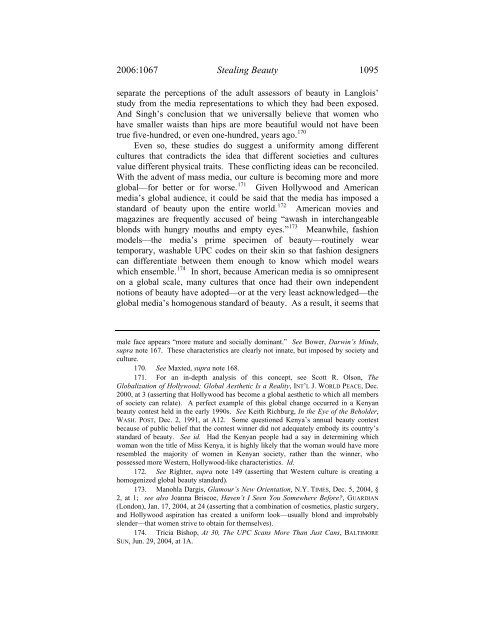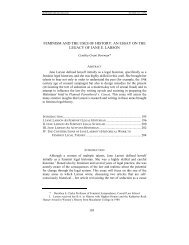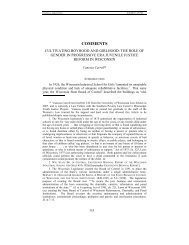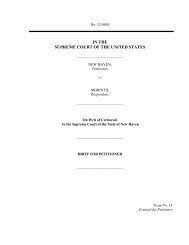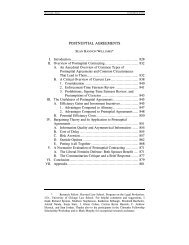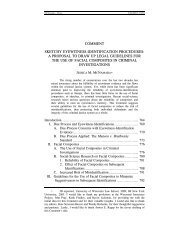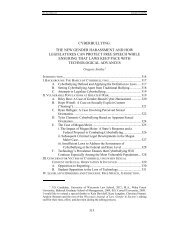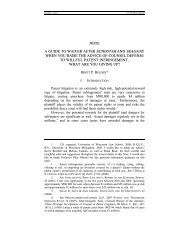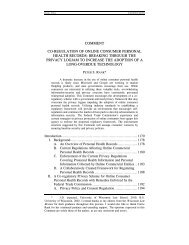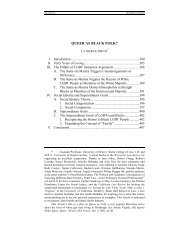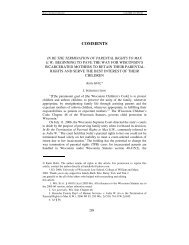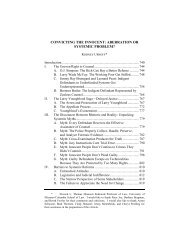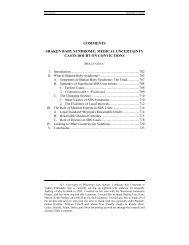Stealing Beauty: Pivot Point International v ... - UW Law School
Stealing Beauty: Pivot Point International v ... - UW Law School
Stealing Beauty: Pivot Point International v ... - UW Law School
You also want an ePaper? Increase the reach of your titles
YUMPU automatically turns print PDFs into web optimized ePapers that Google loves.
2006:1067 <strong>Stealing</strong> <strong>Beauty</strong> 1095<br />
separate the perceptions of the adult assessors of beauty in Langlois’<br />
study from the media representations to which they had been exposed.<br />
And Singh’s conclusion that we universally believe that women who<br />
have smaller waists than hips are more beautiful would not have been<br />
true five-hundred, or even one-hundred, years ago. 170<br />
Even so, these studies do suggest a uniformity among different<br />
cultures that contradicts the idea that different societies and cultures<br />
value different physical traits. These conflicting ideas can be reconciled.<br />
With the advent of mass media, our culture is becoming more and more<br />
global—for better or for worse. 171 Given Hollywood and American<br />
media’s global audience, it could be said that the media has imposed a<br />
standard of beauty upon the entire world. 172 American movies and<br />
magazines are frequently accused of being “awash in interchangeable<br />
blonds with hungry mouths and empty eyes.” 173 Meanwhile, fashion<br />
models—the media’s prime specimen of beauty—routinely wear<br />
temporary, washable UPC codes on their skin so that fashion designers<br />
can differentiate between them enough to know which model wears<br />
which ensemble. 174 In short, because American media is so omnipresent<br />
on a global scale, many cultures that once had their own independent<br />
notions of beauty have adopted—or at the very least acknowledged—the<br />
global media’s homogenous standard of beauty. As a result, it seems that<br />
male face appears “more mature and socially dominant.” See Bower, Darwin’s Minds,<br />
supra note 167. These characteristics are clearly not innate, but imposed by society and<br />
culture.<br />
170. See Maxted, supra note 168.<br />
171. For an in-depth analysis of this concept, see Scott R. Olson, The<br />
Globalization of Hollywood; Global Aesthetic Is a Reality, INT’L J. WORLD PEACE, Dec.<br />
2000, at 3 (asserting that Hollywood has become a global aesthetic to which all members<br />
of society can relate). A perfect example of this global change occurred in a Kenyan<br />
beauty contest held in the early 1990s. See Keith Richburg, In the Eye of the Beholder,<br />
WASH. POST, Dec. 2, 1991, at A12. Some questioned Kenya’s annual beauty contest<br />
because of public belief that the contest winner did not adequately embody its country’s<br />
standard of beauty. See id. Had the Kenyan people had a say in determining which<br />
woman won the title of Miss Kenya, it is highly likely that the woman would have more<br />
resembled the majority of women in Kenyan society, rather than the winner, who<br />
possessed more Western, Hollywood-like characteristics. Id.<br />
172. See Righter, supra note 149 (asserting that Western culture is creating a<br />
homogenized global beauty standard).<br />
173. Manohla Dargis, Glamour’s New Orientation, N.Y. TIMES, Dec. 5, 2004, §<br />
2, at 1; see also Joanna Briscoe, Haven’t I Seen You Somewhere Before?, GUARDIAN<br />
(London), Jan. 17, 2004, at 24 (asserting that a combination of cosmetics, plastic surgery,<br />
and Hollywood aspiration has created a uniform look—usually blond and improbably<br />
slender—that women strive to obtain for themselves).<br />
174. Tricia Bishop, At 30, The UPC Scans More Than Just Cans, BALTIMORE<br />
SUN, Jun. 29, 2004, at 1A.


